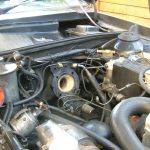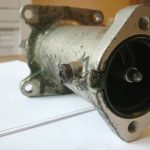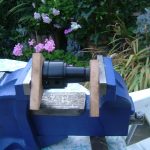Servo Removal
- Linkage
- Brake Pipes
- Servo Removed
- Pump brake pedal until it goes hard
- Remove spring clip from bottom of linkage pin and remove pin
- Remove split-pin and spring
- Syphon out brake fluid from master cylinder reservoir
- Disconnect brake lines from master cylinder
- Disconnect hydraulic pipes from servo
- Remove 4 bolts holding servo in place (loose nuts on back)
- Remove servo & master cylinder
- Place servo in a vice and remove the two bolts holding the master cylinder to the servo
Servo Disassembly
- Set Screw
- All Parts
- Large Piston
- Small Piston
- O-Ring Groove & Backup Ring
WARNING: The set screw is all that holds the servo components in, there is a large spring that will try and throw the components all over the place when you remove the set screw!
- Loosen set scew half a turn using mole grips
- Place servo on workbench master cylinder side down, push down with considerable force, remove set screw and slowly release downward force
- The servo components may be stuck in place by dried up hydraulic fluid, if so carefully prise out the plastic insert by placing a flat bladed screwdriver through the hole in the side of the plastic insert. At some point you’ll break the resistance and if your not careful, everything will go flying. To prevent this place a pile of rags against a wall and place the servo an inch away so that the rags/wall prevent everything coming out.
- Gently remove remaining components, a pair of long-nose pliers wrapped in rags works fairly well.
Oil Seal & O-Rings
- Old Oil Seal Size
- Old/New Oil Seal 1
- Old/New Oil Seal 2
- Old/New O-Rings
The servo contains five o-rings and one oil seal:
- One oil-seal pressed into the plastic insert which seals the output shaft
- One o-ring around the plastic insert which seals the insert to the case
- One o-ring and backup ring in the case which seals the input shaft
- Two o-rings around the larger piston
- One o-ring around the smaller piston
The sizes are as follows:
| Seal | Original Size | Replacement Size |
|---|---|---|
| Oil Seal, plastic insert | 9.5 x 22 x 6/6.5 mm | 9 x 22 x 7 mm, style R21 |
| O-ring, plastic insert | 38.39 x 2.5 x 3.04 mm * | 38 x 3 mm |
| O-ring, main casting | 20.66 x 2.75 x 3.05 mm * | 20 x 3 mm |
| O-rings, large piston | 18.19 x 1.78 x 1.95 mm * | 18 x 2 mm |
| O-ring, small piston | 7.38 x 1.33 x 1.48 mm * | 7 x 1.5 mm |
* The old o-rings no longer had a circular cross section and were quite difficult to measure accurately. The figures shown in the table are the result of averaging several measurements and are stated as: internal diameter x cross-section through ring x cross section flat.
Oil Seal Replacement
- Removing Oil Seal
- Seal Removed
- Pressing In New Seal
- Seal Pressed In
- Seal Replaced
WARNING: The plastic insert is old and brittle and irreplaceable (short of a visit to a local machine shop), you really don’t want to break it!
- Place a hose clamp around the neck of the plastic insert to prevent it expanding too much and shattering while removing the oil seal.
- With a flat bladed screw driver and small hammer, repeatedly hit the back of the oil seal on the same side until it rotates out. Be gentle, it took me the best part of an hour
- Thoroughly clean the plastic insert with a lint free cloth
- Lubricate the new seal with fresh ATF
- Press new seal in with a vise. I found it was necessary to start the seal off at a very slight angle to get it started and then straighten it up by pushing/pulling on the block of wood in the vise at the seal end
O-Ring Replacement
- Piston O-Rings
- Input Shaft O-Ring
- Plastic Insert O-Ring
- Remove the o-rings with the proper tool or a small flat-bladed screwdriver wrapped with several layers of selotape
- Lubricate new o-rings with fresh ATF and install
Reassembly
- Reassembled
- Thoroughly clean everything with a lint free cloth
- Insert small spring and large piston, it may take a bit of force to get it seated properly, once it’s properly seated it should return by the spring pressure if you press it down
- Insert small piston into large piston
- Insert input shaft into case
- Place spring seat over small piston, stack up spring, washer and plastic insert
- Rotate the whole thing so the plastic insert is on the workbench and press the case down over the plastic insert and secure with the set screw. It’s usefull to have a flat-bladed screwdriver to hand as the plastic insert has a habit of twisting slightly as the case is brought down. Placing the screwdriver through the hole in the side of th insert will bring it back into line.
Reinstalling
Reinstalling is the reverse of removal, make sure the input shaft fork goes into the brake pedal linkage correctly before bolting the servo in place as it’s next to impossible to do afterwards (yes, I did forget).





















Recent Comments